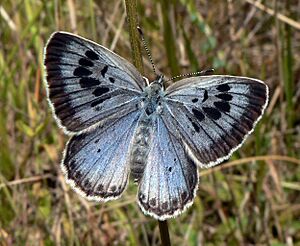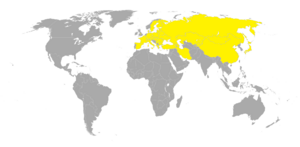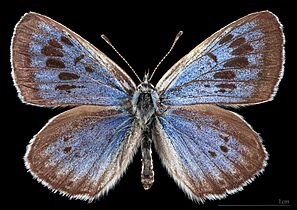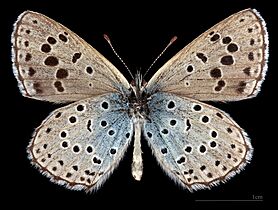Large blue facts for kids
Quick facts for kids Large blue |
|
|---|---|
 |
|
| Upperside | |
 |
|
| Underside | |
| Conservation status | |
| Scientific classification | |
| Genus: |
Phengaris
|
| Species: |
arion
|
 |
|
| Synonyms | |
|
|
The large blue (Phengaris arion) is a special type of butterfly. It belongs to the Lycaenidae family, also known as the gossamer-winged butterflies. This species was first discovered in 1758.
In Great Britain, the large blue butterfly nearly disappeared by 1979. But thanks to new conservation efforts, it has been successfully brought back! Today, the large blue is considered "near threatened" on the IUCN Red List of Threatened Species. You can find P. arion in many places, including Europe, the Caucasus mountains, Armenia, western Siberia, Altai, north-western Kazakhstan, and Sichuan in China.
You can easily spot a large blue butterfly by its unique look. It has blue wings with cool black spots.
This butterfly is famous in animal behavior studies. That's because it's a "brood parasite" of a specific red ant, called Myrmica sabuleti. This means the butterfly tricks the ants into raising its young!
Contents
Types of Large Blue Butterflies
There are several different types, or subspecies, of the large blue butterfly:
- P. a. arion – Found in mainland Europe, western Siberia, Altai, and north-western Kazakhstan.
- P. a. delphinatus (Fruhstorfer, 1910)
- P. a. zara Jachontov, 1935 – Found in the Caucasus and Armenia.
- P. a. buholzeri Rezbanyai, 1978
- † P. a. eutyphron Fruhstorfer, 1915 – This type used to live in southern Britain but is now extinct.
What the Large Blue Looks Like
Large blue caterpillars are small, growing to about half an inch (13 millimeters) long. They spend up to 9 months as caterpillars. Then, they change into a chrysalis before becoming a butterfly.
Large blue butterflies are one of the biggest in their family. Their wings can spread up to 2 inches (51 millimetres) wide. Adult butterflies only live for a few weeks. Their wings are blue with black spots.
Where Large Blue Butterflies Live
The large blue butterfly lives across a wide area called the Palearctic realm. This includes Europe and parts of Asia. They are most common in areas from France to China.
Large Blue Butterfly Habitat

The large blue butterfly needs specific places to live. Its home depends on where its food sources are found. For the caterpillars to survive, they need lots of Thymus drucei plants to eat. They also need Myrmica sabuleti ants nearby.
Scientists have found that a varied landscape is key for the large blue's survival. They thrive in pastures and old fields with different kinds of plants and bushes. If the landscape is too uniform, important natural events might happen at the same time. This makes the butterfly population more vulnerable to problems like bad weather. Having different types of areas helps the butterflies survive. It creates different microclimates (small local climates) that are very important for them.
Conservation Efforts
In the late 1900s, large blue butterfly numbers dropped sharply across Europe. By the 1950s, only about 100,000 adults were left in Britain. By 1978, almost half of Britain's known large blue populations were gone.
At first, experts were puzzled because the butterfly's habitats didn't seem to have changed. They thought collectors, insecticides, or air pollution might be to blame. Many projects tried to fix these issues, but they didn't work. The species disappeared from the Netherlands in 1964 and from the UK in 1979. In Belgium, it was thought to be extinct until a new population was found in 1996. Populations also decreased a lot in Denmark, Germany, France, and Estonia.
The main reason for these declines was a lack of understanding about the butterfly's behavior. Now, the large blue butterfly is critically endangered in Britain. It is also endangered in many other parts of Europe. It's a top priority species under the UK Biodiversity Action Plan.
Good news! A long-term conservation project in the UK has helped a lot. In 2022, the number of large blue butterflies increased significantly. The species is now described as "thriving" in some areas.
Saving the large blue butterfly can also help other endangered species. For example, the Myrmica ants, the large blue butterfly, violet seeds, and the violet-feeding butterfly (Boloria euphrosyne) are all connected. The ants carry violet seeds into their nests. These seeds often grow inside the nest. If large blue caterpillars eat too many ant larvae, the ants might leave the nest. This helps the violet seeds grow better. Since B. euphrosyne butterflies like violets growing on empty ant nests, the large blue indirectly helps them too!
Life Cycle and Behavior
Brood-Parasitic Behavior
Like many butterflies in the Phengaris group, large blues are brood parasites. This means they rely on another insect to raise their young. In this case, their hosts are certain types of Myrmica ants.
Phengaris caterpillars are very clever. They look and smell like Myrmica ants when they are young. This trick makes the ants carry them back to their nest. Once inside, the caterpillar does one of two things: it either eats the ant larvae, or it pretends to be an ant larva and begs for food. This begging method is called a "cuckoo" strategy. Studies show that the "cuckoo" method often results in more butterfly larvae surviving per nest. However, large blue butterflies are known to act as predators, eating the ant larvae in the host nests.
Scientists first thought that each Phengaris species only tricked one specific Myrmica ant species. For the large blue, it was thought to be M. sabuleti. But newer research shows that each Phengaris species can trick more than one Myrmica species. Still, they usually prefer one main ant species. The large blue butterfly strongly prefers M. sabuleti, but it has also been seen preying on M. scabrinodis. In Finland, large blue butterflies only used M. lonae nests. The exact details of this host-parasite relationship are still being studied.
Female Egg-Laying Behavior
For the caterpillars to survive, female butterflies must lay their eggs where the right kind of Myrmica ants can find them. Female Phengaris butterflies lay their eggs on specific plants, like thyme. Wild thyme is the favorite food plant in the UK. In colder or mountainous parts of Europe, they prefer marjoram.
After about three weeks, the eggs hatch. The tiny caterpillars then eat the seeds and flowers of the plant. The caterpillar stays near its food plant until it reaches its 4th stage of growth. Then, it drops to the ground. From there, the caterpillar uses different tricks to be found by Myrmica ants.
Some Phengaris caterpillars, like P. rebeli and P. alcon, release special scents called pheromones. These scents copy the pheromones of ant larvae. This trick makes the ants think the caterpillars are their own young, so they carry them back to the nest and feed them. It was once thought that the large blue butterfly didn't do this, or did it poorly. But now we know it does release semiochemicals (chemical signals) to trick the ants. Large blue caterpillars sometimes follow ant trails or move away from their food plant when ants are most active. This helps them be found by Myrmica ants specifically, not other ant types. Once in the nest, the ants usually ignore the caterpillar because it doesn't draw attention. We are still learning exactly how large blue caterpillars interact with their host ants.
Behavior in the Host Nest
Once adopted into an ant nest, Phengaris larvae use one of two main strategies.
Predator Strategy
Unlike some other Phengaris species, the large blue caterpillar becomes a predator once it's in the ant nest. It eats the ant pupae (young ants) while still pretending to be a Myrmica ant. Even with this clever trick, many large blue caterpillars don't survive in the nest.
One reason for this is that each Phengaris species is best suited for only one type of Myrmica ant. Caterpillars adopted by the wrong ant species are often killed and eaten. Even if they find the correct host, many large blue butterflies still might not survive. If their disguise isn't perfect, and the ants become suspicious, the caterpillar is likely to die. Also, ants in nests without enough food are more likely to spot the large blue as an intruder. Large blue caterpillars are most often attacked during the first 10 days after being adopted. This is because they grow bigger than typical Myrmica ant larvae during this time.
Mimicry
Even after getting into the ant nest, Phengaris butterflies keep up their act. They use sounds to trick the ants. Many studies show that ants use sounds to communicate. Phengaris butterflies use this to their advantage. For example, P. rebeli caterpillars make sounds that copy the unique sound of the queen ant. This makes the worker ants treat them like royalty! They even rescue the caterpillar before their own young if there's danger.
It was once thought that only "cuckoo" strategy species used sound mimicry. But now we know that the large blue also uses chemical signals to gain acceptance.
Survival in the Nest
Lab studies show that large blue butterfly larvae first eat the biggest ant larvae. This is smart because the largest larvae provide the most food. It also stops these larvae from growing into adult ants, which would be too big to eat. While in the nest, large blue caterpillars gain most of their weight. They grow from about 1.3 milligrams to 173 milligrams.
Scientists estimate that one butterfly needs about 230 large ant larvae and at least 354 Myrmica workers to survive. However, such a large ant nest is rare in the wild. This shows that large blue butterflies are very good at surviving without food for long periods. This is helpful if the ants leave the colony and abandon the caterpillar. Large blue butterflies have even been known to move to new nests if their first one is deserted. Sometimes, a nearby ant colony will move into the empty nest. This allows the surviving large blues to trick multiple Myrmica colonies.
Predator vs. Cuckoo Strategies
Scientists are still trying to understand why there are different strategies inside the ant nest. The "cuckoo" strategy results in six times more butterflies per nest than the predatory strategy. This might make the cuckoo strategy seem better. However, there are other things to consider.
Cuckoo caterpillars stay very close to the ants. This means they must produce chemicals that are almost identical to the host ant species to survive. This is why cuckoo strategy users are more likely to be attacked by the host colony if they are adopted by the wrong ant species. Current information suggests that cuckoo strategy users depend on one specific Myrmica ant species. Predatory Phengaris butterflies, like the large blue, are more adaptable overall. But they still do best with a specific ant species.
See also






